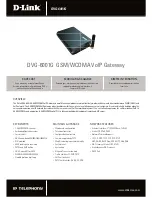
Ù
ÔÑÍÍßÎÇ
98
operator depending on performance requirements, operating preferences,
and regulatory constraints.
ÝÐÛ
Customer-Premises Equipment. Terminal equipment provided by a service
provider that is located at a subscriber
s premises and supports a
communication channel between a customer and the service provider.
ÜÒÍ
Domain Name System.
A system used for translating host names for
network nodes into IP addresses.
ÜØÝÐ
Dynamic Host Configuration Protocol. Provides a framework for passing
configuration information to hosts on a TCP/IP network. DHCP is based on
the Bootstrap Protocol (BOOTP), adding the capability of automatic
allocation of reusable network addresses and additional configuration
options.
Û
ÒÝÎÇÐÌ×ÑÒ
Data passing between a base station and subscribers uses encryption to
protect from interception and evesdropping.
Û
ÌØÛÎÒÛÌ
A popular local area data communications network, which accepts
transmission from computers and terminals.
ÛßÐ
Extensible Authentication Protocol. An authentication protocol used to
authenticate subscribers. EAP is used with TLS or TTLS authentication to
provide
mutual authentication
between a subscriber and a WiMAX
network.
ØÌÌÐ
Hypertext Transfer Protocol. HTTP is a standard used to transmit and
receive all data over the World Wide Web.
×ÝÓÐ
Internet Control Message Protocol. A network layer protocol that reports
errors in processing IP packets. ICMP is also used by routers to feed back
information about better routing choices.
×ÛÛÛ èðîòïï
Þ
The Wi-Fi wireless standard that supports communications in the 2.4 GHz
band using Direct Sequence Spread Spectrum (DSSS). The standard
provides for data rates of 1, 2, 5.5, and 11 Mbps.
×ÛÛÛ èðîòïï
Ù
The Wi-Fi wireless standard that supports communications in the 2.4 GHz
band using using Orthogonal Frequency Division Multiplexing (OFDM). The
standard provides for data rates of 6, 9, 11, 12, 18, 24, 36, 48, 54 Mbps.
IEEE 802.11g is also backward compatible with IEEE 802.11b.







































